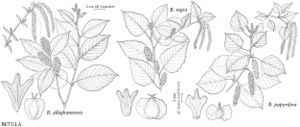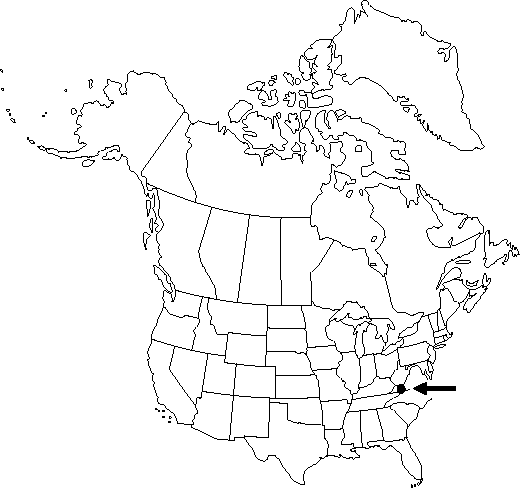Difference between revisions of "Betula uber"
Rhodora 47: 325. 1945.
FNA>Volume Importer |
FNA>Volume Importer |
||
| Line 27: | Line 27: | ||
}}<!-- | }}<!-- | ||
| − | --><span class="statement" id="st- | + | --><span class="statement" id="st-undefined" data-properties=""><b>Trees,</b> slender, to 10 m. <b>Bark</b> dark brown, smooth, close. <b>Twigs</b> with taste and odor of wintergreen when crushed, glabrous, covered with small resinous glands. <b>Leaf</b> blade nearly orbiculate to broadly elliptic with 2–6 pairs of lateral veins, 2–5 × 2–4 cm, base rounded to cordate or truncate, margins irregularly serrate or dentate, apex broadly obtuse to rounded; surfaces abaxially glabrous to sparsely pubescent, especially along major veins and in vein axils, often with scattered resinous glands. <b>Infructescences</b> erect, ellipsoid-cylindric, 1–2 × 1–1.5 cm, shattering with fruits in fall; scales glabrous, lobes diverging distal to middle, central lobe ascending, shorter than lateral lobes. <b>Samaras</b> with wings narrower than to as wide as body, broadest near summit, extended beyond body apically.</span><!-- |
-->{{Treatment/Body | -->{{Treatment/Body | ||
| Line 59: | Line 59: | ||
|publication year=1945 | |publication year=1945 | ||
|special status=Conservation concern;Endemic | |special status=Conservation concern;Endemic | ||
| − | |source xml=https://jpend@bitbucket.org/aafc-mbb/fna- | + | |source xml=https://jpend@bitbucket.org/aafc-mbb/fna-data-curation.git/src/9216fc802291cd3df363fd52122300479582ede7/coarse_grained_fna_xml/V3/V3_743.xml |
|subfamily=Betulaceae subfam. Betuloideae | |subfamily=Betulaceae subfam. Betuloideae | ||
|genus=Betula | |genus=Betula | ||
|species=Betula uber | |species=Betula uber | ||
| − | |||
| − | |||
| − | |||
| − | |||
| − | |||
| − | |||
| − | |||
| − | |||
| − | |||
| − | |||
| − | |||
| − | |||
| − | |||
| − | |||
| − | |||
| − | |||
| − | |||
| − | |||
| − | |||
| − | |||
| − | |||
| − | |||
| − | |||
| − | |||
| − | |||
| − | |||
| − | |||
| − | |||
| − | |||
}}<!-- | }}<!-- | ||
-->[[Category:Treatment]][[Category:Betula]] | -->[[Category:Treatment]][[Category:Betula]] | ||
Revision as of 13:48, 27 July 2019
Trees, slender, to 10 m. Bark dark brown, smooth, close. Twigs with taste and odor of wintergreen when crushed, glabrous, covered with small resinous glands. Leaf blade nearly orbiculate to broadly elliptic with 2–6 pairs of lateral veins, 2–5 × 2–4 cm, base rounded to cordate or truncate, margins irregularly serrate or dentate, apex broadly obtuse to rounded; surfaces abaxially glabrous to sparsely pubescent, especially along major veins and in vein axils, often with scattered resinous glands. Infructescences erect, ellipsoid-cylindric, 1–2 × 1–1.5 cm, shattering with fruits in fall; scales glabrous, lobes diverging distal to middle, central lobe ascending, shorter than lateral lobes. Samaras with wings narrower than to as wide as body, broadest near summit, extended beyond body apically.
Phenology: Flowering late spring.
Habitat: Stream banks and adjacent flood plains in rich mesic forest
Elevation: 500 m
Discussion
Of conservation concern.
Betula uber, described in 1918, was not seen again until its widely celebrated rediscovery in 1974 (P. M. Mazzeo 1974; C. F. Reed 1975; D. W. Ogle and P. M. Mazzeo 1976; D. J. Preston 1976). It is apparently allied to B. lenta (W. J. Hayden and S. M. Hayden 1984; T. L. Sharik and R. H. Ford 1984); whether it constitutes a separate species or simply mutant individuals of B. lenta is a matter of controversy. Seeds obtained from the original single extant population of 17 trees and grown at the U.S. National Arboretum have produced an apparent hybrid swarm of offspring varying in leaf characteristics from those of B. uber to those of B. lenta (with which it occurs).
Selected References
None.

